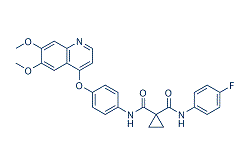| Description: |
Cabozantinib is a potent multiple receptor tyrosine kinases inhibitor that inhibits VEGFR2, c-Met, Kit, Axl and Flt3 with IC50s of 0.035, 1.3, 4.6, 7 and 11.3 nM, respectively. |
| In Vivo: |
Tumor vascularity decreases after Cabozantinib (XL184), with reductions ranging from 67% at 3 mg/kg to 83% at 30 mg/kg for 7 days[1]. In mouse models, Cabozantinib dramatically alters tumor pathology, resulting in decreased tumor and endothelial cell proliferation coupled with increased apoptosis and dose-dependent inhibition of tumor growth in breast, lung, and glioma tumor models. Importantly, treatment with Cabozantinib does not increase lung tumor burden in an experimental model of metastasis, which has been observed with inhibitors of VEGF signaling that do not target MET. On a body weight dosage basis, Cabozantinib plasma exposures range from 6- to 10-fold higher in rats than in mice, which accounts for lower doses inducing tumor growth inhibition/regression in rats than in mice. Subchronic administration of Cabozantinib is well tolerated in mice and rats with no signs of toxicity, as determined by stable and/or increasing body weights during the treatment period[2]. |
| In Vitro: |
Cabozantinib is a potent inhibitor of MET and VEGFR2 with IC50 values of 1.3 and 0.035 nM, respectively. MET-activating kinase domain mutations Y1248H, D1246N, or K1262R are also inhibited by Cabozantinib (IC50=3.8, 11.8, and 14.6 nM, respectively). Cabozantinib displays strong inhibition of several kinases that have also been implicated in tumor pathobiology, including KIT, RET, AXL, TIE2, and FLT3 (IC50=4.6, 5.2, 7, 14.3, and 11.3 nM, respectively). In cellular assays, Cabozantinib inhibits phosphorylation of MET and VEGFR2, as well as KIT, FLT3, and AXL with IC50 values of 7.8, 1.9, 5.0, 7.5, and 42 μM, respectively. The effect of Cabozantinib on proliferation is evaluated in a number of human tumor cell lines. SNU-5 and Hs746T cells harboring amplified MET are the most sensitive to Cabozantinib (IC50=19 and 9.9 nM, respectively); however, SNU-1 and SNU-16 cells lacking MET amplification are more resistant (IC50=5,223 and 1,149 nM, respectively). MDA-MB-231 and U87MG cells exhibit comparable levels of sensitivity to Cabozantinib (IC50=6,421 and 1,851 nM, respectively), whereas H441, H69, and PC3 cell lines are the least sensitive to Cabozantinib with IC50 values of 21,700, 20,200, and 10,800 nM, respectively. In addition, BaF3 cells expressing human FLT3-ITD, an activating mutation in acute myelogenous leukemia, are sensitive to Cabozantinib (IC50=15 nM) when compared with wild-type BaF3 cells (IC50=9,641 nM)[2]. |

 DC Chemicals' products qualify for U.S. tariff exemptions. We guarantee no price increases due to customs duties and maintain stable supply, continuing to deliver reliable research solutions to our American clients.
DC Chemicals' products qualify for U.S. tariff exemptions. We guarantee no price increases due to customs duties and maintain stable supply, continuing to deliver reliable research solutions to our American clients.





















